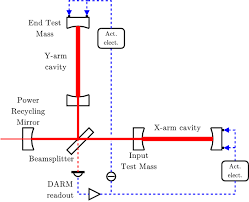So, the
“mathematico-physical” prediction of that gifted brain of Einstein, which
remained as the figment of imagination for over a century, has at last been
proved right: Two black holes, set about
a kilometre away from each other—one containing 36 times as much mass as the
Sun and the other 29 times—were locked in an orbital dance. Accelerating
rapidly, it brought them closer. Finally, when they met, there was a violent
wobble for a minute as quintillions upon quintillions of mass redistributed. And
in a jiffy, a larger black hole was formed.
The new black hole is, however, less than the sum of its parts. For, the
rest, equivalent to three solar masses, turned into energy. The thus released
energy travelled across space as a gravitational wave for 1.3 billon years, the
undulations of which were finally picked up on September 14, 2015 by the
Advanced Laser Interferometer Gravitational Wave Observatory (LIGO) located in Washington
and Louisiana in the US. And Lo! The experimental physicists have finally identified
the first gravitational wave.
Announcing
the detection of the gravitational wave—“the
famous chirp” denoted as GW150914—to the world on February 11, the experimental
physicists have finally vouch for Einstein’s general theory of relativity. This
announcement by David Reitze, Ligo executive director, is indeed hailed by the
physicists as a bigger event than even the detection of Higgs boson in 2012,
for it has more profound implications:
- It provides a direct evidence of the existence of black holes
- Gravitational waves can be used as new tool to probe the universe
- Astronomers can now ‘hear’ the phenomena of ripples in space
- One day we may even be able to listen to the echoes of the Big Bang and eavesdrop on the first 400,000 years of the universe
- Astronomers can also probe into the cosmic mystery of ‘dark matter’ that remained elusive to the conventional telescopes
For Indians and particularly, for those theoretical
physicists who were to limit their association with this historical event to the
extent of providing theoretical inputs or data analysis, what is more exciting
is that immediately after the announcement of detection of gravitational waves,
the government of India has announced its in-principle approval for
establishing a gravitational wave detector in India—a clearance that is under
examination for almost five years. And
this news is greeted by the world with joy—a rare phenomenon, indeed. The
reasons are, of course, not far to seek: the presence of another Ligo of same
sensitivity at thousands of kilometres away from the US observatories will only
enhance the level of accuracy and ability to detect new gravitational events.
To better appreciate this fact, let us
first take a quick look at how Ligo works. It is designed to detect the tiny
changes—expansions and contractions of about one thousandth the diameter of a
proton—caused by the gravitational wave sent out by a cosmic cataclysm in the
galaxy. It is “L” shaped with two four-kilometre arms set at right angles to
one another. There is a tunnel in each
arm carrying a laser beam. As the name itself indicates, the Interferometer
splits a laser beam in two. Then sends the halves to and fro along the identical
paths—the arms set at right angles to one another. Later, when the halves come
back to converge at the crux of the arms, they travel in step to the detector.
But when a gravitational wave arrives at the interferometer, it alters the
space-time—stretches space in one direction and shrinks it in the direction
that is at right angle—as a result of which
when the beams recombine and arrive at the detector, they are no longer
in step, indicating a signal.
However,
lot of care needs to be exercised to make it absolutely certain that what is noticed
is gravitational wave, for even a distant seismic rumblings or the vibrations
of passing traffic can distort the observations. Secondly, there being only two functional detectors in the world today, it is not possible to triangulate a signal. Which
is why, it is not possible to exactly locate the origin of the gravitational waves. Increased
number of Ligos will also increase our ability to detect far away signals
too. As India is strategically situated,
when our observatory becomes functional, it simply enhances accuracy of
observations—observing the same signal, of course, not quite simultaneously, by centres located in different geographies ensures certainty of the wave. That is where India’s decision to erect its own Ligo with an
investment of Rs. 1200 cr made the world hoot for it.
That
aside, the very erecting of the Ligo will alter the landscape of Indian
science. For, although critical components such as mirrors and lasers are to be
imported from the US, fabrication of ultra-high capacity vacuum system that can
handle one million litres of vacuum and manufacturing of secondary optics are
to be done in India. The experience of engineering
and assembly of the equipment of such high precision nature is sure to lift
Indian industry’s capabilities in precision engineering in several other
areas.
This
mega science project will draw more students into gravitational wave
physics. As one scientist observed, this
facility will simply “improve chances of doing science in India.” And, I for
one fervently hope that the erection of LIGO will give the much needed kick to
the Indian Science that is incidentally lying dormant since quite some time.
Pictures: Courtesy: Google images


No comments:
Post a Comment